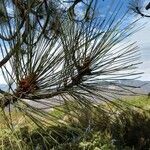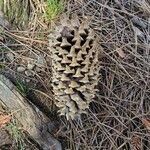Trees to 24 m; trunk to 1 m diam., straight to contorted; crown broad, thin, irregular. Bark dark gray-brown to near black, deeply furrowed, with long, scaly, irregularly anastomosing, rounded ridges. Branches often ascending; twigs stout to moderately slender, violet-brown, often glaucous, aging gray-brown, rough. Buds ovoid, deep red-brown, 1.5(-3) cm, resinous; scale margins white-fringed, apex cuspidate. Leaves 3 per fascicle, slightly spreading, not drooping, mostly ascending in a brush, persisting 3-4 years, 15-30 cm x ca. 2 mm, slightly curved or straight, twisted, dusty gray-green, all surfaces with pale, fine stomatal lines, margins serrulate, apex abruptly subulate; sheath 2-4 cm, base persistent. Pollen cones ovoid to cylindric, to 25 mm, light purple-brown, aging orange-brown. Seed cones maturing in 2 years, gradually shedding seeds thereafter and moderately persistent, massive, heavy, drooping, asymmetric at base, narrowly ovoid before opening, ovoid-cylindric when open, 20-35 cm, pale yellow-brown, resinous, stalks to 3 cm; apophyses transverse-rhombic, strongly and sharply cross-keeled, elongate, curved, continuous with umbos to form long, upcurved claws 2.5-3 cm. Seeds obovoid; body 15-22 mm, dark brown; wing to 25 mm.
An evergreen tree. It grows 25 m tall. The bark is purple-brown and scaly. The leaves are needle like and stiff. They are 30 cm long and in clusters of three. They are grey-green on stout shoots. The cones are very large. They can be 30 cm long by 15 cm wide. The seeds are large and edible.








